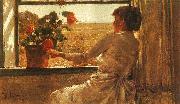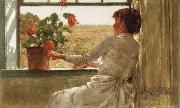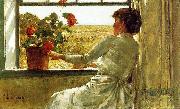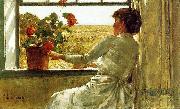
|
Childe Hassam
|
|||
|
|
|||
| 1859-1935 Childe Hassam Locations Frederick Childe Hassam (b. October 17, 1859, Dorchester, Boston, Massachusetts ?C d. August 27, 1935, East Hampton, New York) was a prominent and prolific American Impressionist painter, noted for his urban and coastal scenes. Along with Mary Cassatt and John Henry Twachtman, Hassam was instrumental in promulgating Impressionism to American collectors, dealers, and the museums. He produced over 3,000 paintings, watercolors, etchings, and lithographs in his career, and was a founding member of The Ten, an influential group of American artists of the early 20th century. His most famous works are the ??Flag?? paintings, completed during World War I. Hassam (pronounced HASS'm;) (known to all as Childe, pronounced like child) was born in his family home in a suburb of Boston in 1859. His father Frederick was a cutlery merchant and descended from a long line of New Englanders, while his mother Rosa was a native of Maine. He demonstrated an interest in art early in his life. He had his first lessons in drawing and watercolor while attending the Mather public school, but his parents took little notice of his nascent talent. A disastrous fire in November 1872 wiped out much of Boston??s commercial district including his father??s business. To help out the family, Hassam dropped out of high school and his father lined up a job for him in the accounting department of publisher Little Brown & Company. His poor aptitude for figures, however, convinced his father to allow him to pursue an art career, and Hassam found employment with George Johnson, a wood engraver. He quickly proved an adept draftsman (??draughtsman?? in the Boston directory) and he produced designs for commercial engravings, such as images for letterheads and newspapers. Around 1879, Hassam began creating his earliest oil paintings but his preferred medium was watercolors, mostly outdoor studies. | |||
|
|
|||
|
Summer Evening Childe Hassam34.jpg Painting ID:: 4106 |
1886 Hartford Steam Boiler Inspection and Insurance Co | ||
|
|
|||
|
Childe Hassam
|
|||
|
|
|||
| 1859-1935 Childe Hassam Locations Frederick Childe Hassam (b. October 17, 1859, Dorchester, Boston, Massachusetts ?C d. August 27, 1935, East Hampton, New York) was a prominent and prolific American Impressionist painter, noted for his urban and coastal scenes. Along with Mary Cassatt and John Henry Twachtman, Hassam was instrumental in promulgating Impressionism to American collectors, dealers, and the museums. He produced over 3,000 paintings, watercolors, etchings, and lithographs in his career, and was a founding member of The Ten, an influential group of American artists of the early 20th century. His most famous works are the ??Flag?? paintings, completed during World War I. Hassam (pronounced HASS'm;) (known to all as Childe, pronounced like child) was born in his family home in a suburb of Boston in 1859. His father Frederick was a cutlery merchant and descended from a long line of New Englanders, while his mother Rosa was a native of Maine. He demonstrated an interest in art early in his life. He had his first lessons in drawing and watercolor while attending the Mather public school, but his parents took little notice of his nascent talent. A disastrous fire in November 1872 wiped out much of Boston??s commercial district including his father??s business. To help out the family, Hassam dropped out of high school and his father lined up a job for him in the accounting department of publisher Little Brown & Company. His poor aptitude for figures, however, convinced his father to allow him to pursue an art career, and Hassam found employment with George Johnson, a wood engraver. He quickly proved an adept draftsman (??draughtsman?? in the Boston directory) and he produced designs for commercial engravings, such as images for letterheads and newspapers. Around 1879, Hassam began creating his earliest oil paintings but his preferred medium was watercolors, mostly outdoor studies. | |||
|
|
|||
|
Summer Evening new12/Childe Hassam-946466.jpg Painting ID:: 38797 |
mk141 1886 Oil on canvas 30.8x51.7cm | ||
|
|
|||
|
Louis Lcart
|
|||
|
|
|||
| French (1880-1950) Louis Icart was born in Toulouse, France. He began drawing at an early age. He was particularly interested in fashion, and became famous for his sketches almost immediately. He worked for major design studios at a time when fashion was undergoing a radical change-from the fussiness of the late nineteenth century to the simple, clingy lines of the early twentieth century. He was first son of Jean and Elisabeth Icart and was officially named Louis Justin Laurent Icart. The use of his initials L.I. would be sufficient in this household. Therefore, from the moment of his birth he was dubbed 'Helli'. The Icart family lived modestly in a small brick home on rue Traversi??re-de-la-balance, in the culturally rich Southern French city of Toulouse, which was the home of many prominent writers and artists, the most famous being Henri de Toulouse-Lautrec. Icart fought in World War I. He relied on his art to stem his anguish, sketching on every available surface. It was not until his move to Paris in 1907 that Icart would concentrate on painting, drawing and the production of countless beautiful etchings, which have served (more than the other mediums) to indelibly preserve his name in twentieth century art history. When he returned from the front he made prints from those drawings. The prints, most of which were aquatints and drypoints, showed great skill. Because they were much in demand, Icart frequently made two editions (one European, the other American) to satisfy his public. These prints are considered rare today, and when they are in mint condition they fetch high prices at auction. Art Deco, a term coined at the 1925 Paris Exposition des Arts Decoratifs, had taken its grip on the Paris of the 1920s. By the late 1920s Icart, working for both publications and major fashion and design studios, had become very successful, both artistically and financially. His etchings reached their height of brilliance in this era of Art Deco, and Icart had become the symbol of the epoch. Yet, although Icart has created for us a picture of Paris and New York life in the 1920s and 1930s, he worked in his own style, derived principally from the study of eighteenth-century French masters such as Jean Antoine Watteau, François Boucher and Jean Honor?? Fragonard. In Icart's drawings, one sees the Impressionists Degas and Monet and, in his rare watercolors, the Symbolists Odilon Redon and Gustave Moreau. In fact, Icart lived outside the fashionable artistic movements of the time and was not completely sympathetic to contemporary art. Nonetheless, his Parisian scenes are a documentation of the life he saw around him and they are nearly as popular today as when they were first produced. In 1914 Icart had met a magical, effervescent eighteen-year-old blonde named Fanny Volmers, at the time an employee of the fashion house Paquin. She would eventually become his wife and a source of artistic inspiration for the rest of his life. | |||
|
|
|||
| This artist (Louis Lcart) is not available now. | |||
|
|
|||
|
Childe Hassam
|
|||
|
|
|||
| 1859-1935 Childe Hassam Locations Frederick Childe Hassam (b. October 17, 1859, Dorchester, Boston, Massachusetts ?C d. August 27, 1935, East Hampton, New York) was a prominent and prolific American Impressionist painter, noted for his urban and coastal scenes. Along with Mary Cassatt and John Henry Twachtman, Hassam was instrumental in promulgating Impressionism to American collectors, dealers, and the museums. He produced over 3,000 paintings, watercolors, etchings, and lithographs in his career, and was a founding member of The Ten, an influential group of American artists of the early 20th century. His most famous works are the ??Flag?? paintings, completed during World War I. Hassam (pronounced HASS'm;) (known to all as Childe, pronounced like child) was born in his family home in a suburb of Boston in 1859. His father Frederick was a cutlery merchant and descended from a long line of New Englanders, while his mother Rosa was a native of Maine. He demonstrated an interest in art early in his life. He had his first lessons in drawing and watercolor while attending the Mather public school, but his parents took little notice of his nascent talent. A disastrous fire in November 1872 wiped out much of Boston??s commercial district including his father??s business. To help out the family, Hassam dropped out of high school and his father lined up a job for him in the accounting department of publisher Little Brown & Company. His poor aptitude for figures, however, convinced his father to allow him to pursue an art career, and Hassam found employment with George Johnson, a wood engraver. He quickly proved an adept draftsman (??draughtsman?? in the Boston directory) and he produced designs for commercial engravings, such as images for letterheads and newspapers. Around 1879, Hassam began creating his earliest oil paintings but his preferred medium was watercolors, mostly outdoor studies. | |||
|
|
|||
|
Summer Evening new24/Childe Hassam-966974.jpg Painting ID:: 72911 |
"Summer Evening," oil on canvas, by the American artist Childe Hassam. 12.13 in. x 20.38 in. Courtesy of the Florence Griswold Museum, Old Lyme, Connecticut. Image courtesy of The Athenaeum cjr | ||
|
|
|||
|
Childe Hassam
|
|||
|
|
|||
| 1859-1935 Childe Hassam Locations Frederick Childe Hassam (b. October 17, 1859, Dorchester, Boston, Massachusetts ?C d. August 27, 1935, East Hampton, New York) was a prominent and prolific American Impressionist painter, noted for his urban and coastal scenes. Along with Mary Cassatt and John Henry Twachtman, Hassam was instrumental in promulgating Impressionism to American collectors, dealers, and the museums. He produced over 3,000 paintings, watercolors, etchings, and lithographs in his career, and was a founding member of The Ten, an influential group of American artists of the early 20th century. His most famous works are the ??Flag?? paintings, completed during World War I. Hassam (pronounced HASS'm;) (known to all as Childe, pronounced like child) was born in his family home in a suburb of Boston in 1859. His father Frederick was a cutlery merchant and descended from a long line of New Englanders, while his mother Rosa was a native of Maine. He demonstrated an interest in art early in his life. He had his first lessons in drawing and watercolor while attending the Mather public school, but his parents took little notice of his nascent talent. A disastrous fire in November 1872 wiped out much of Boston??s commercial district including his father??s business. To help out the family, Hassam dropped out of high school and his father lined up a job for him in the accounting department of publisher Little Brown & Company. His poor aptitude for figures, however, convinced his father to allow him to pursue an art career, and Hassam found employment with George Johnson, a wood engraver. He quickly proved an adept draftsman (??draughtsman?? in the Boston directory) and he produced designs for commercial engravings, such as images for letterheads and newspapers. Around 1879, Hassam began creating his earliest oil paintings but his preferred medium was watercolors, mostly outdoor studies. | |||
|
|
|||
|
Summer Evening new24/Childe Hassam-948636.jpg Painting ID:: 74725 |
"Summer Evening," oil on canvas, by the American artist Childe Hassam. 12.13 in. x 20.38 in. Courtesy of the Florence Griswold Museum, Old Lyme, Connecticut. Image courtesy of The Athenaeum. cyf | ||
|
|
|||
|
Also Buy::. For Following Paintings / Artists / Products, Please Use Our Search Online: |











